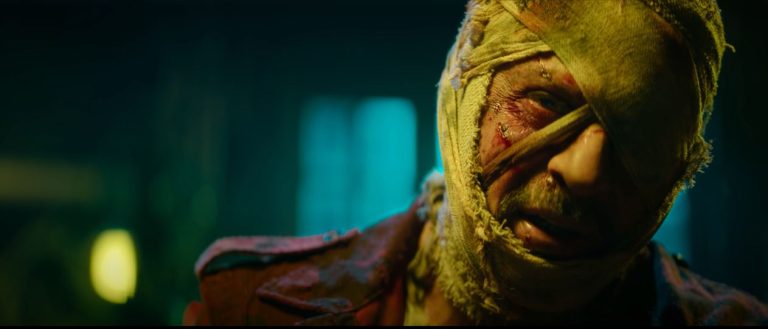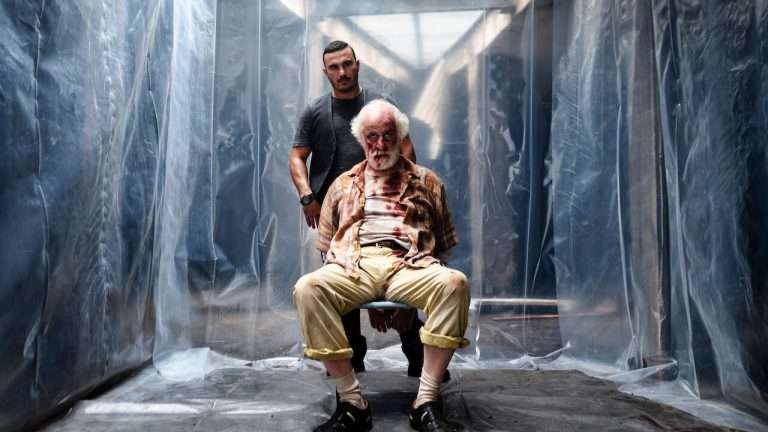“Dream Scenario (2023)” marks Kristoffer Borgli’s third directorial venture, presenting an easily approachable yet distinctively eccentric narrative, a trait that harmoniously aligns with A24’s distribution involvement. Starring Nicolas Cage, renowned for his diverse and often unconventional movie choices, adds a unique flair to the movie. Borgli ingeniously crafts a narrative landscape in this film, weaving a tapestry that not only showcases an inventive setup but also probes deeply into the dynamics of cancel culture. While this theme might not be novel, the manner in which it unfolds, especially towards the Dream Scenario’s ending, is a testament to Borgli’s ability to revitalize familiar topics with a fresh perspective, ensuring the conclusion packs a significant punch.
Dream Scenario (2023) Plot Summary & Movie Synopsis:
Paul Matthews is an unassuming and normal biology professor whose wife loves him, and his two teenage kids tolerate him. His dream is to finish a book on his long-gestating research on collective consciousness through the study of ants, or “antelligence.” To that end, he almost had lunch with an ex-colleague of his, and he accused her of plagiarizing his work. However, his life slowly starts to change when his students and colleagues start seeing him in their dreams as an unassuming bystander just standing at the corner or walking away.
Paul’s journalist ex-girlfriend meets Paul and his wife Janet while they are on the way out of the theater and tells him that he has been appearing in her dreams. She asks permission to write about these sightings, which he grants. This leads to Paul overnight becoming a celebrity of sorts, with hundreds of messages flooding into his messenger and his students in the class interacting with him while they describe their dreams.
What is remarkable is Paul’s passivity in those dreams, which makes him somewhat disconcerted, as it also mirrors his behavior in real life. He does revel in the attention, though, having given a televised interview talking about being the subject of everyone’s dreams. Even his relationship with his wife starts to improve, with her describing her fantasy of Paul saving her while wearing the oversized suit that David Byrne of the Talking Heads used to sport in live concerts.
But the perils of being in the mind of every person on the planet soon make their way onto Paul’s doorstep, as his house is broken into at night by a mentally ill person who tries to kill him. He manages to assuage the man and call the cops, after which he is forced to contact a PR firm (titled Thoughts?). The head of the firm, Trent (Michael Cera), and one of his partners, Mary (Kate Berlant), are very interested in using Paul’s newfound ability to harness marketing by trying to advocate for him to join as a Sprite spokesperson.
That would inadvertently cause people to dream of Paul with a sprite in his hand. Who knows, he might be able to meet Obama in his dreams if Trent’s plans come to fruition. However, Paul’s ambitions are simpler. He wants the power of the PR firm to help him find a publisher so that he can talk about his research. While he manages to convince them, he also realizes that the goals of the PR firm aren’t congruent with his.
Why does Paul in the dreams become scary?
One of the interns of the firm, Molly, had seperate sort of dreams regarding Paul, which she had hesitated to talk about. She invites Paul out to dinner, where she reveals that in her dream, she has sex with him, and he very much takes the lead, which surprises Paul. The night turns even more bizarre when Molly invites him to her home after Paul sees people take pictures of him on their phones. At Molly’s home, Molly plans to re-enact her dream, which Paul is hesitant about but ultimately agrees to. It doesn’t end well for Paul as he prematurely ejaculates and leaves humiliated. The humiliation exacerbates further for him when she sees his colleague has published the paper on the idea she had ostensibly stolen from him.
But as it turns his newfound active role in the dreams and in reality has a profound impact. Because now people are visualizing nightmares featuring Paul in them. His younger daughter dreams of him entering her room like a ghost. His students visualize him either choking them or beating and killing them with a hammer. These nightmarish images soon spread throughout the world, affecting Paul’s life as well as the life of his family. His classes are soon turning out empty, he is forbidden from attending dinner at his colleague’s because his wife dreamed Paul choking her to death.
Bystanders begin to notice Paul in the streets and are bothered by his presence, while students in his school paint LOSER in big, bold bink letters on the side of his car, leading to him having a meltdown, but to no avail. His problems reach a fever pitch when having lunch by himself in a restaurant, he is asked to leave because the customers are feeling uncomfortable by his presence. His refusal leads to an altercation with one of the customers and Paul being sent to the hospital, hurt and needing treatment.
What does Paul see in his dream?
Upon returning from the hospital after being picked up by Janet, Paul dreams that night of walking down an empty suburban street and finding himself attacked by a man wearing a combat jacket and brandishing a crossbow. Resting on the porch of the house after finding himself impaled by arrows, Paul sees his attacker raising his crossbow for the kill shot and realizes that the attacker is himself, or rather the violent version of Paul witnessed by people around the world while dreaming. He also sees his impaling being visualized as a live theatre segment, with a version of himself in the audience looking on.
This leads to easily the most cringe moment, and some might argue that this is the climax of the film. Paul records a public apology to be transmitted around the world, except his apology becomes a vindication for him as he tries to explain how he had been a victim this entire time. The embarrassing apology doesn’t endear him to his family members or the audience at large. His family has already been suffering because association with him (Janet is fired from her job while her younger daughter is getting picked on at school, and his eldest daughter has depression), and this apology is the last straw.
Janet asks him to leave the house. Paul, to maintain some semblance of normalcy, tries to watch his daughter’s school play but is forbidden from attending it. That night, Paul stays over at his friend’s house, who is also the principal of the school he teaches. However, his friend can only afford to have him sleep in the basement, but he is curiously unable to turn off the light. The next day, he tries to forcefully enter via the theatre’s back entrance to watch his daughter’s play but injures one of the teachers in the process.
Dream Scenario Ending Explained:
What is Norio?
A couple of months later presumably, the dreams have stopped. We now see Paul’s ability to appear in dreams has been discovered and harnessed by an inventor, based on the concept of a shared dream consciousness, kind of resembling Paul’s theory of “antelligence.” And as expected in a world where social media and targeted marketing have proliferated in every sphere, even dreams are now fertile ground for advertising. The Norio works as a smartwatch, whereby the person who wants to enter someone’s dream should meditate or be in a sleep-induced state, wearing that gadget that would arm him to enter someone else’s dream. As expected, dreamscapes start to become like a website infested with pop-up ads, as Paul would later witness in one of the film’s final scenes.
What happens to Paul?
Remember Jason Lee’s character Syndrome’s logic in the animated film “The Incredibles”? “I will grant everyone superpowers. Thus when everyone is super, no one will be.” When everyone has the power to travel in dreams, why should Paul be any special? So the hatred towards Paul by the populace has decreased and transformed into curiosity and intrigue. While searching for a house on the market with his daughters, Paul has a conversation with the realtor, where the realtor reveals that her friend had the dream of Paul trying to choke her to death, but that, too, is in doubt. Paul doesn’t react, apparently used to being recognized now for his ability to appear in dreams.
We learn that Paul has separated from Janet, and his children, too have limited contact with him. It is strongly implied that both Janet and Paul have feelings for each other, as evident by their teary goodbyes as Paul leaves for a month-long book tour in Paris. It is revealed that the book in question is his autobiography titled “Dream Scenario,” but changed to “I am your Nightmare” without his consent.
He is also seen photographed with a metallic glove resembling the clawed hands of Freddy Kreuger, the prime attraction of “The Nightmare on Elm Street” film series. “Dream Scenario” becomes somewhat like a comedic reversal of the concept of “Elm Street” as visualized by Wes Craven. Meanwhile, his book tour doesn’t go very well, and he is forced to shift to the basement of the book store, and even gets injured in the process by a faulty tube light rod (curiously similar to the one he can’t turn the light off at the basement of his friend’s house).
What dream does Paul see at the end?
Paul uses the Norio device to travel to Janet’s dream where they re-enact Janet’s fantasy of Paul rescuing her from being burnt at the stake, with him wearing the oversized jacket of David Byrne. As the two of them dance together, Paul expresses his wish that it was real before being lifted away.
Was it all a dream?
There is a strong interpretation that all of these events are occurring as dreams. One of the strongest clues comes with the tube light rod, which Paul can’t switch off at his friend’s basement. Psychiatrists believe that light levels in dreams can be changed, but it is quite uncommon and a well-known trigger for lucidity. A subsequent clue would be a similar-looking tube light rod falling on Paul’s head again, forming a scar similar to the one Paul had obtained during his altercation at the restaurant. It leaves room for interpretation that the entire third act might be one elaborate dream.
What is Dream Scenario about?
On the one hand, Dream Scenario could be taken as Kristoffer Borgli’s treatise on the perils of fame and going viral on the internet. On that front, the jokes and memes that resulted within the world of the film all felt on point. It then becomes a treatise about cancellation culture and the non-apologetic apology video being made to save face. It is an event witnessed far too often, especially amongst celebrities who have been unearthed of past offenses and craft a PR-mandated speech to save face.
Also, Read: 10 Best Nicolas Cage Movie Performances
At the end of the day, Dream Scenario is about a character study, as evidenced by the movie not stopping even after Paul is evicted from his house by his wife. The dreams keep changing and Paul in the dreamscape being visualized as violent or aggressive are hinted throughout the film, be it Paul’s insecurity or his passive-aggressive nature of conversing with his colleagues and his wife. This is a man dissatisfied with his lot in life who revels in the attention and is not unhappy to reap the benefits of his newfound fame, but it’s the indiscretion that Paul willingly tries to be a part of with Molly that becomes his undoing.
To a certain extent, the film works, especially because Cage’s performance is sufficiently off-kilter that you are always on your toes, even when his character is unassuming at the onset. The setup is inventive, as is the visualization of the dream sequences. It begins to lose its potency as it slowly tries to bring in the themes of modern-day issues—the vices of social media and its proliferation in marketing—and the third act, trying to become a potent satire, falls flat. Cage’s performance, as well as Julliane Nicholson’s, does work, but as with these high-concept film projects, it does fall flat by the finish line.






![The Founder [2017]: Tragedy behind Happy Meal](https://79468c92.delivery.rocketcdn.me/wp-content/uploads/2017/01/the-founder-movie-2016-trailer-michael-keaton-768x385.jpg)


